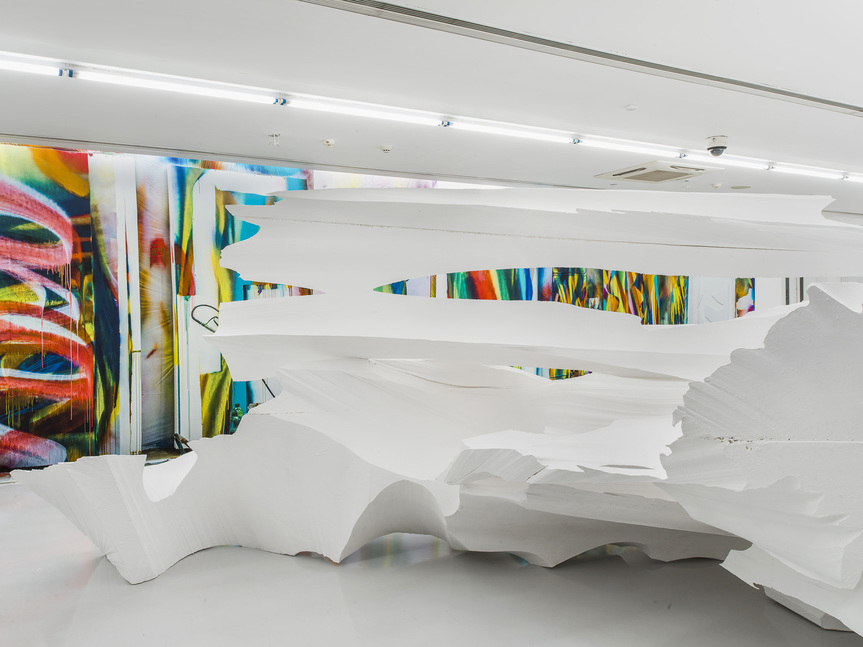-
From Current Issue
-
- Editor’s Letter Fire in the Heart
- Reviews I Gusti Ayu Kadek Murniasih
- Reviews 11th Seoul Mediacity Biennale: “One Escape at a Time”
- Dispatch Networked China
- One on One Monira Al Qadiri on Yukio Mishima
- Essays The rise of independent art spaces in pandemic-era Shanghai
- Features Tuan Andrew Nguyen
- Table of Contents
- Web Exclusives
- Archive
- Subscribe

R
E
V N
E
X
T
Installation view of KATHARINA GROSSE’s “Mumbling Mud” at Chi K11 Art Museum, Shanghai, 2018. All images by JJYPHOTO; courtesy K11 Art Foundation and Galerie nächst St. Stephan, Vienna; copyright the artist and VG Bild-Kunst, Bonn.
For Katharina Grosse’s first solo exhibition in China, “Mumbling Mud,” the internationally acclaimed German artist aimed her spray gun at Shanghai’s Chi K11 Art Museum, firing liters of paint across swatches of fabrics, piles of soil and spreads of furniture. Housed in the 1,500-square-meter basement of K11 Art Mall, a multi-level shopping complex that distinguishes itself by incorporating contemporary art as part of the consumer experience, the show led visitors through immersive, Instagrammable landscapes of colorful and material extravagance. Although it was not site-specific, the display was site-appropriate, approximating a contemporary art articulation of the hyper-capitalist environment under which it resided.
The basement of the K11 Art Mall has always made for an awkward exhibition space, given its particular spatial constraints: low ceilings, lack of natural light, exposed utilities and a warren of disconnected rooms. Grosse’s maximalist, in-situ painting style, which is usually manifest in cavernous halls with vertically imposed fabric drapes, were shown across five individual sections (titled “Underground,” “Ghost,” “Silk Studio,” “Stomach” and “Showroom”) at K11, and the exhibition as a whole felt like a giant trapped in a doll house. Further, one could not help but marvel at the amount of waste that the show generated—a pressing concern in an increasingly environmentally damaged world.
“Underground” comprised a post-apocalyptic scene of mud, building waste and the general deritus that one expects to find in enormous piles behind shopping complexes, all adorned in Grosse’s typical spray-painted palette. “Ghost” featured an enormous carved block of Styrofoam—a material conventionally used for exhibitions as little more than a “temporary” packing material intended to be discarded—resembling a traditional scholar’s rock that has been toppled in a foreign assault. “Silk Studio”was a presentation of floor-to-ceiling silk prints with color images of Grosse’s Berlin studio and previous projects—exhibits that are normally displayed as collateral information to provide context, but that, in Grosse’s show, acted as a work based on recollection. “Stomach” was a labyrinthine construction of hundreds of meters of folded and draped fabric—a format typical of Grosse’s most recent installations—which, like any maze, befuddled and assaulted the senses. The final zone, “Showroom,” looked like a lounge that had been attacked by anarchic graffiti artists with a welcome knowledge of modernist art history.
The museum’s press release states that the exhibition “invite[s] rumination into the quintessential strangeness of a metropolis that is ever-changing and impossible to be delineated in simple contours,” which I read as a way to shoehorn Grosse’s practice into a specific relationship with Shanghai. Though the city is undeniably ever-changing, apart from Grosse having been invited to engage with local painters during her visit to China, there was no reason to associate “Mumbling Mud” with Shanghai. Indeed, at a talk at the Goethe-Institut following the opening, such site-specificity was discounted by Ulrich Loock, curatorial advisor for the show. Loock argued contrastively that Grosse’s works do not rely on the paint or the material, but the idea that travels between locations. The idea itself remained unarticulated.
Loock’s assertion raised questions as to the wastefulness of Grosse’s practice, which neither the artist nor K11 curator Venus Lau adequately addressed. Lau attempted to refute the point by highlighting that the exhibition will travel to other K11 venues in China (although she admitted that she did not necessarily mean the physical components), while Grosse pointed out that certain sections, such as “Silk Studio” and “Showroom,” could be collected by the museum. Ultimately, what was identified as reusable amounted to a small proportion of the overall installation, relegating the majority of the material as waste, in this and consecutive displays.
In a general sense, many art practices and venues present a troublingly mute response to environmental issues—both art fairs and galleries consume inordinate volumes of building materials and power—but Grosse’s exhibition was a particularly ostentatious example of the art world’s inability to address wastefulness. “Mumbling Mud” was an embodiment of and a perfectly situational response to the excesses of the late-capitalist era.
Katharina Grosse’s “Mumbling Mud” is on view at the Chi K11 Art Museum, Shanghai, until February 24, 2019.
To read more of ArtAsiaPacific’s articles, visit our Digital Library.



















